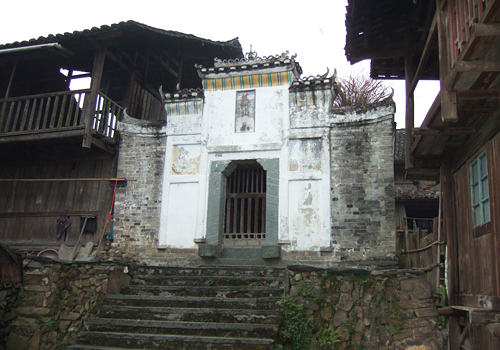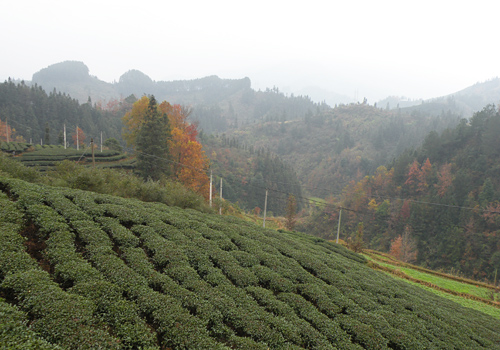A Trip to the Dong Minority Area, Part Ⅱ
2013-01-23China travel Guide
After saying goodbye to the happy old men in the Elderly's Recreation Center, we walked our way up along the stairs paved with slate. We then came to Feishan Temple, a place where the Dong villagers worship their ancestors of ancient tribes. It's located half way up on a mountain slope and occupies an area of thirty square meters or so, not that big. Both the threshold and the door frames are made of local shale of a sandy nature. Entering the temple, we could see a shrine in the center of the wall facing the door. A sign for worship was inside, inscribed as "The Holy Site for the Authority, Feishan King ". There was a pot containing incense on a table in front of the shrine so the incense can be burned while worshiping. There were signs for Buddhism and Daoism on the wall near the shrine, so it can be a temple for both religions.

We left the Temple, continued to walk up, step by step, on the stairs of slate till we reached the top of the mountain. From there we had a bird's eye view of the valley, and saw the whole village down below. Gaoyou village is thirty nine km away from the county town of Sanjiang, and twenty km from Chengyang Wind and Rain Bridge. There are more than four hundred households, and almost two thousand people in total.
After leaving Gaoyou village, we took the road to another Dong village by the name of Gaoxiu. Soon we arrived at a fork of the road where we saw a middle aged man sitting on a tractor that was parked. We asked him which way was the correct road to Gaoxiu village. He pointed to the gravel road on the right and said, "This is the shorter way to Gaoxiu." We turned right, which ended up being a bit bumping, with steep bends in the road. As we drove, the road kept getting more and more narrow. Somewhere along the way we got our wheels stuck and they began to spin. Finally, following that rough mountain road for five km we arrived in Gaoxiu, a beautiful village surrounded by green mountains. It has two hundred thirty five households and nearly one thousand people in total.

Walking into the village, we could see a few drum towers stretching their heads above the densely laid houses of the Ganlan style. Because Ms. Zhao called ahead, we were able to drive to our host’s home directly. The owner, Shi Ke, was the head of the village. His wife, with a one-year old baby in her arms, came out to welcome us enthusiastically. She then showed us into their house. On the ground floor, many wooden wardrobes and stools were put together tidily, giving off the light smell of fir wood. We were then taken to the second floor, where lots of wooden beds and mattresses were kept. We were told that Mr. Shi was a carpenter with excellent craftsman skills. He had worked as a carpenter in the county town of Sangjiang in his younger days. He was multitalented, being able to building houses, make furniture, etc. A few years ago, he decided not to live any longer as a migrant worker in Sanjiang, so he came back to stay in his village. He was elected as head of the village, for he was a capable craftsman and has seen the outside world. We met Mr. Shi in the living room on the second floor. Being a man of about 40 years old, he looked capable, experienced and sincere. Sitting around a fire of burning charcoal, we started to talk with him. He told us that the charcoal was made from the wood of chestnut trees. They use it for drying the baby’s clothes, as well as heating the house in winter. It costs between one hundred twenty and one hundred fifty yuan to buy fifty kilos of charcoal at the market place. Later, I asked him about the oil rich camellia trees we saw growing on the mountainside on our way into the village. He told us those trees are one of the two types of commercial plants in the mountainous area of the Dong minority, the other being the tea trees or bushes. It had recently been the season for harvesting camellia seeds, that's why there was a big pile of them around a corner in Mr. Shi's house. These seeds were deep brown in color like chestnuts and looked as big as a fingernail. The cooking oil refined from the seeds is considered organic, healthy, and comparable to olive oil. At the moment, the government was introducing a better species for the villagers to plant. During our conversation, Mr. Shi introduced a young man in his thirties to us, "This is the expert for researching camellia seeds from the Forestry Bureau of the County, who has come to help us increase the growing of new species of camellia trees."

While we were talking, the women got our lunch ready. We were invited to the table by the warm-hearted host. A steaming hotpot was on the table, with food boiling inside, smelling delicious. The host served us full glasses of rice wine, the women sang Dong folk songs then proposed a toast for us. At the end of singing, we shouted out "Yalawoo!" with them together, then drank the wine bottoms up. After putting the wine into my mouth, I tasted its pleasant aroma all around my mouth and could still taste it later. After the wine, a bowl of sliced sour pork was brought to the table, the host saying, "All right, as the saying goes, 'The Dong people cannot live without food of a sour taste.' Now please try the sour pork from our Dong families.” I took a piece into my mouth with the chopsticks. It was a bit sour and spicy, very unique. While we were eating I asked, "Why do the Dong people have preserved sour meat?" "We Dong people mainly live in the mountainous region. In the past, we killed chickens, ducks and pigs only on special occasions like New Years and festivals. After the festivals, there would be some meat left, we put some salt and massaged it into the meat before we put it into a clay pot for preserving. The meat could be kept for quite a long time, up to one year, and would remain good for eating. The meat or fish preserved in the pot would slowly ferment, hence it became sour meat or fish. Of course, we could take some out of the clay pot to eat at anytime. We do like to treat our VIPs with such a dish in our Dong villages." What Mr. Shi explained to us helped us understand why the Dong people have the tradition of eating sour food. After the meal, I was allowed to go to the storage room downstairs so that I could have a look of those clay pots for preserving sour food. Being made of clay, they are a meter and a half tall, each with a big belly but small opening on top. There is a groove around the neck of it, and a lid like a big bowl covers it upside down. By putting some water or camellia oil around the groove, air can be kept from going inside, thus preventing the meat inside from going bad...
--- VisitOurChina





I recently came acrocss your blog and have been reading along. I thought I would leave my first comment. I dont know what to say except that I have enjoyed reading. Nice blog. I will keep visiting this blog very often.___________________Jessica
Email: pjfrutuoso@fundacaodpedroiv.org